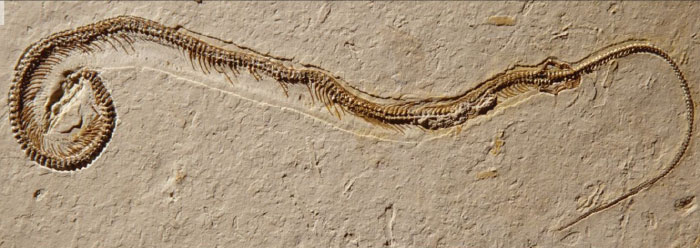As weird as it may sound, some snakes had legs. Fossils reveal little legs on ancient snakes that have apparently been extinct for some time. Yet, those had only hind legs. Now, in the journal Science researchers describe a new fossil with four limbs. They suggest that this new fossil illustrates how legged snakes evolved from legged lizards. Is this accurate?
Researchers have known that all legged snakes looked like snakes. They were long and tubular with many vertebrae. Legged snake fossils also have the characteristic snake skull. For example, lizard skulls have a raised eyebrow ridge, but the top of a snake's skull is flat.
This new fossil named Tetrapodophis found in a private collection is no exception to the trend. The Science study authors wrote, "The snake-like spine and reduced limbs of Tetrapodophis suggest that the animal engaged in characteristic serpentine locomotion, with the limbs playing little or no role in locomotion."1 Perhaps they didn't play a role in locomotion, but maybe they played a role in mating—like the hind spurs of modern pythons.
Researchers agree that snakes lost their legs over time. Possibly the newfound four-legged snake represents an earlier form of a particular snake kind.2 Could God have created a four-legged snake that lost its legs after He cursed the world? For all we know, He may have made some snake kinds with no legs and others with the genetic ability to turn leg production on or off.
We know animal populations have lost appendages. For example, the famous flightless weevils of genus Galapaganus inhabit the gusty Galapagos Islands, and comparing them with continental varieties reveals they lost their wings. Also, some salamanders have apparently lost limbs, and ancient eels may have had larger fins than those in modern populations.
'Legless lizards' have either reduced or absent limbs. The reduced legs look a bit out of place, similar to legged snakes known from fossils. Perhaps for some of them, legs just get in the way. In other words, whereas legless lizards with reduced limbs may still be in the process of losing them, it appears several snake varieties finished that same process long ago.
The Science study authors wrote, "As the only known four-legged snake, Tetrapodophis sheds light on the evolution of snakes from lizards." Just what light would that be? Based on characteristics that show it was not a marine snake, "Tetrapodophis therefore supports the hypothesis that snakes evolved from burrowing rather than marine ancestors."1 But from what burrowing ancestor did it evolve? They have no idea.
According to evolutionary dogma, snakes evolved from lizards. But nobody has yet identified a candidate part-lizard/part-snake fossil creature. Instead, all we have are either snakes or lizards. These snakes with little legs were still just snakes—not in-between forms. This complete lack of any evolutionary pre-snake forms is why "their evolutionary origins are obscure." And after this fascinating new fossil, their origins remain just as obscure as before.
Thus, Tetrapodophis sheds no light on snake origins.
So far, the data show that snakes have always been snakes—whether they had legs or not. This fits God's Word where He described making creatures to reproduce after their kinds, not in-between kinds. And a fallen creation full of creatures with the genetic potential to produce trait variations in offspring explains snakes losing legs over time. This new fossil highlights the once-good creation that sin corrupted described in Genesis. Now, that story has legs.
November 2, 2016 update:
In the months following this “four-legged-snake” report in the journal Science, paleontologists have expressed doubts about it actually being a snake. If it really was a snake, then it would be the only possible evolutionary missing link between lizards and snakes. Now, some experts are calling it an extinct marine lizard—not a snake after all.
Science News reports that attendees of the 2016 Society of Vertebrate Paleontology also express frustration over the now-controversial fossil’s inaccessibility, in violation of standard protocol.3 Why hide it? Was it really a snake, or just a lizard?
While we wait for answers to these questions, we don’t have to wait to answer this one: Was it an evolutionary missing link? As this ICR article argued, if it was a snake it only shows variation within a snake kind. Meanwhile, this scrum reemphasizes that there is no such thing as a transitional form without dispute among evolutionists.
References
- Martill, D. M., H. Tischlinger, and N. R. Longrich. 2015. A four-legged snake from the Early Cretaceous of Gondwana. Science. 349 (6246): 416-419.
- Or possibly it was not a snake. Some paleontologists wonder if it was an extinct amphibian. See Perkins, S. Four-legged snake fossil stuns scientists—and ignites controversy. Science News. Posted on news.sciencemag.org July 23, 2015, accessed August 4, 2015.
- Gramling, C. Controversial ‘four-legged snake’ may be ancient lizard instead. Science News. Posted on sciencemag.org/news November 1, 2016, accessed November 2, 2016.
Image credit: Copyright © 2015. D. Martill. Adapted for use in accordance with federal copyright (fair use doctrine) law. Usage by ICR does not imply endorsement of copyright holders.
*Mr. Thomas is Science Writer at the Institute for Creation Research.
Article posted on August 10, 2015, updated November 2, 2016.





















